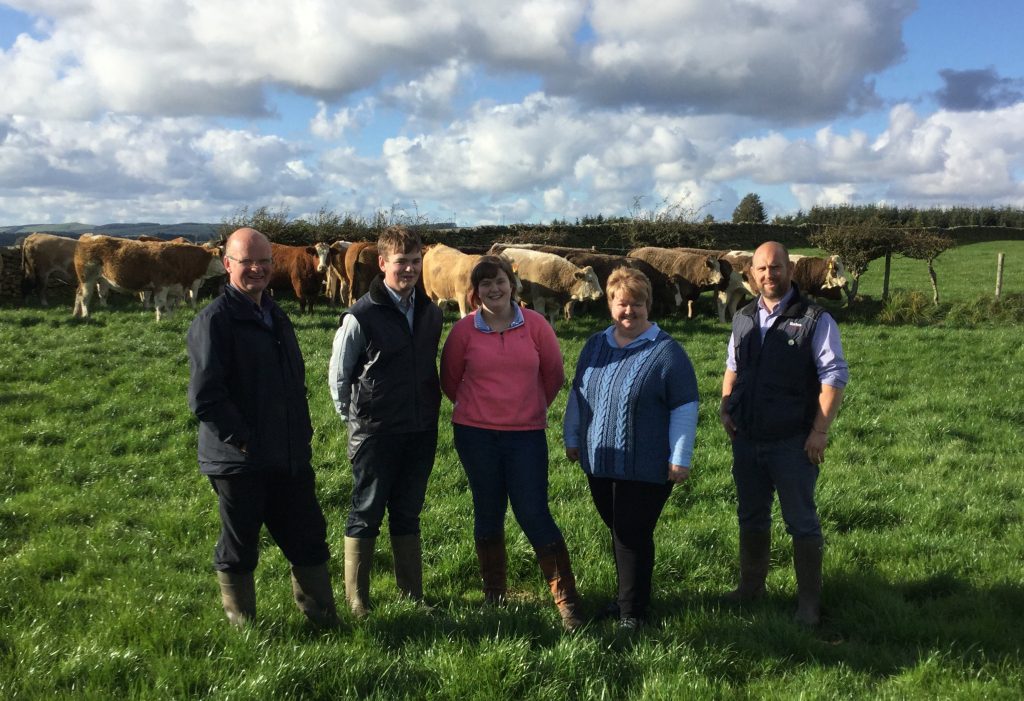The many improvements a Dumfries family has made on their farm during their time as Quality Meat Scotland (QMS) monitor farmers are highlighted in a new video.
During the past three years, the Paterson family at Hartbush, Amisfield, Dumfries, have managed to increase stock numbers while significantly improving the health and production of their sheep and cattle enterprises. They have also reduced their seasonal lets and their acreage of barley grown to concentrate on improving the grass at the 245 ha home farm.
John Paterson, who farms Hartbush with his wife Amanda, their children Louise and Steven together with additional team member Colin Rae, admits it took some arm-twisting to persuade him to become a monitor farmer back in 2012. However, he has no regrets and believes it was a great learning curve which has led him to be more open to changes in their farms system.
“We were very lucky to have an extremely strong and open community group. Our average attendance at the meetings was 67, and some of the meetings, especially those covering vet topics, attracted over 100 people.”
From the outset, animal health was one of the key focus areas at Hartbush and the Patersons started with the basics by soil sampling and improving the pH by applying 1100 tonnes of lime over three years.
“It was quite a significant investment but well worth it as there is a visible improvement in the grass and we can carry more stock on it,” Mr Paterson said.
The family also embarked on colostrum testing the calves from their herd of 270 suckler cows which calve from the end of March through to the beginning of May. This three-year trial was fully funded by the farm’s vet practice, the Nithsdale Vet Group, with the benefit of the results shared with the Patersons and the wider farming community.
The outcome of this testing is that the Patersons now ensure that newborn calves suck within two to three hours of birth. This has led to more vigorous calves and fewer problems with scour.
Over the past three years the family has sown more young grass and adopted a rotational grazing system to optimise grass volume and quality, which has allowed them to increase their cow numbers by 20 and ewe numbers from 360 to 450.
Apart from about 30ha of seasonal grass beside the farm, the Patersons have stopped renting grazing. This is because they feel they have more control over the grass at home and the management decisions they have taken in recent years has meant they can produce more kg of meat per hectare.
The cows are mostly Simmental cross with the family concentrating on breeding their own high health replacements, paying close attention to genetics and selecting only the best so they can improve the kg of meat sold per cow.
Bull calves are usually kept entire and sold to Highland Meats at 13 to 14 months at around 360kg with three-quarters of them achieving U grade. However this year the family castrated their male calves and will either graze them next summer or sell them as forward stores in the spring. The heifers have been on a paddock grazing system for two years now. Improved grassland management and productivity has increased daily liveweight gains to 0.93kg, compared with 0.74kg on a set stocking system.
The Patersons have also been practising rotational grazing with the cows, moving them every three days. This has kept them closer to the bull and given grass time to regenerate. They have also seen real benefits of rotational grazing on their hill ground.
“The grass has been better than ever even on the fairly steep hill and the benefit is you get a much more even use of the hill by the cows, resulting in improved fertility and grass growth on all parts of the hill,” said Mr Paterson.
The family are continuing with set stocking of the half-bred ewes which are put to a Suffolk tup, but as a result of grass improvement they have increased their numbers. Nearly all the ewe lambs are sold for breeding to regular buyers and this year 320 averaged £85.17. The wedders are finished from grass and sold at Dumfries Market where they average 42kg liveweight.
Although their experience as a Monitor farmer is nearly over, the Patersons said it has opened their minds to new ideas and they will continue to drive the business forward to produce as much quality beef and lamb as possible from the home farm.
Photo Caption: The Paterson family and team member Colin Rae (far right) on Hartbush farm, near Dumfries.






